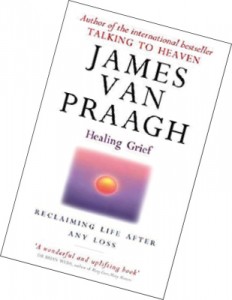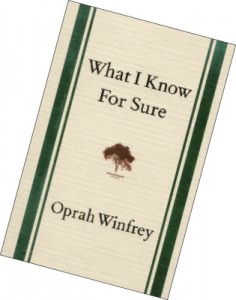
One of the reasons I am a fan of M S Dhoni is that he always speaks about the importance of living in the moment. In the context of his sport, cricket, he always points out that yesterday’s victory or defeat ends with yesterday and who knows what tomorrow will bring. All that matters is being one hundred per cent in the game at this moment. This philosophy lends itself to application in various aspects of life. At the personal level, when I lost my mother recently, one thing that got me through that day was being, willy-nilly, in the moment; and there’s no reason to doubt that this is the experience of many others.

It is in the context of bereavement and dealing with raw grief that a dear friend with long years of compassionate practice as a doctor in North Carolina sent me two books: Healing Grief: Reclaiming Life After Any Loss by James Van Praagh and What I Know For Sure by Oprah Winfrey. To refresh your memory, Van Praagh is a clairvoyant and spiritual medium; Oprah is a talk show host, media executive, actor and TV producer. My friend assured me that both these authors had continued to help her through difficult and confusing periods of loss and grief.
The fact is, self-help books simply do not appeal to me, and these, in a way, are in that category: they purport to help you help yourself, at least in spirit. So it was with a great deal of scepticism that I started reading them. The motivating factor was that they were gifts from an individual whom I love and respect, and who has a scientific temper… she’s a doctor, after all.
For starters, both books are well written. Van Praagh communicates in a direct, simple manner matters that are really quite mind-boggling to comprehend. He talks about connecting with those who have passed on to another world, meaning, people who have died, in order to bring clarity into the worlds of those still living. While some of us take the phenomenon of death as a fact, there are many who have endless questions about it and the afterlife. Why do we die? What happens after death? Where do we go after we have shaken off our mortal coils? Is my loved one safe out there? These are some of the questions that haunt parents and children and friends who have suffered bereavement. I realised this with greater clarity only after I had myself lost my second parent and begun to feel rudderless, adrift and regretful.
Reading Van Praagh, irrespective of his role as a spiritual medium, has been a calming, enabling experience, insightful yet reassuring. It has also underlined the fact that tragic loss is not necessarily tied only to death, although this may be a dominating feature. It is tied to separation, divorce, the loss of home, a painful illness, midlife crisis, aging, or even the death of pets. While his other books are more about his life and work as a clairvoyant and medium, Healing Grief focuses on the aftermath of loss, discussing feelings in detail and offering guidelines for healing at the end of each section.

Although hardcore scientists would pooh pooh the definition, the word déjà vu is generally supposed to describe the feeling of having been somewhere or seen/experienced something before, of something seeming familiar and already known. Most people have had this feeling of déjà vu sometime or the other. Sometimes there’s a rational explanation for this, sometimes there’s not. For instance, you meet someone and instantly connect, almost as though you have known her from before. So, when Van Praagh writes, “From a spiritual point of view, divorce occurs because karmic obligations between two souls must be met. Souls reincarnate together during a lifetime to fulfill a soul contract”, it makes sense in an intangible way even if you do not believe in karma or soul or reincarnation or god. This will help those going through the painful self-questioning and recrimination that follows divorce or a fallout.
The author asks his father if being old has taught him anything. “Oh, yes,” he replies. “I have had a lot of time to contemplate my life, and I keep thinking over and over again, if I only knew then what I know now. I took life for granted in many ways. One doesn’t realise how precious life is. It all goes by so fast…” When I stop to think, I wonder where all my years went, and how they sped past so swiftly.
The book also asks us to remember that love never dies, fear is an illusion, we never stop learning; you should value every moment and tell those you love what’s in your heart. We cannot control the universe but we can control ourselves, share our tears and laughter. He also suggests some exercises that could help us learn more about ourselves and negotiate grief, because grieve we must.
Oprah Winfrey’s book is more elegant in every way: it’s look, the scope of its ideas, as well as the writing. The book arose from a question she was asked by the Chicago Tribune film critic, Gene Siskel: “Tell me, what do you know for sure?” Her attempt to answer this question invites us to share her insight from her own life about joy, resilience, connection, gratitude, awe, clarity and power. As the back cover of the book declares, “I know for sure: Your journey begins with a choice to get up, step out, and live fully.”
Oprah’s book, like Van Praagh’s, resonates with the spirit, but unlike his, resides in this realm. It emerges from her own experiences of growing up in indigent circumstances and making a life for herself despite the odds. “Stop waiting for your husband to say ‘I appreciate you,’” she writes, “your kids to tell you what a great mother you are, a man to whisk you away and marry you, or your best friend to assure you that you’re worth a darn. Look inward — the loving begins with you.” This is exactly what Anita Moorjani, author of Dying to be Me, says in her TEDx talk about her near-death experience. Her top five lessons about living will surely resonate, even with the sceptics: focus on love and first of all, love yourself; live life fearlessly; embrace humour, laughter and joy; life is a gift; and always be yourself.

The key to any relationship, writes Oprah, is communication. She talks about consciously taking the decision one fine day to be in touch with people in the neighbourhood, a decision that enabled her to feel she belonged, that she was part of an active and lively community. She too talks about life being a gift and some of the things she delights in doing to celebrate this gift, such as planting vegetables in her garden, reading a great book, sleeping till her body wants to wake up, being still, expressing gratitude…
She often asked herself, in her journal, what she was afraid of: “Over time I realised that while I had often seemed brave on the outside, I had lived much of my inner life in bondage. I was afraid that others wouldn’t like me. I was terrified that if I said no to people, they would reject me. Everything I did, thought, felt, said, or even ate was connected to the fear I carried around with me — and I allowed it to block me from ever knowing who I really was.” It’s true, she says, you don’t have to prove anything to anybody but yourself.
As you read, Oprah forces you to look inward, examine your own life. It’s easier to give up than to persist, but it’s the getting “back on your feet no matter how many times you’ve failed” that’s the true measure of courage. Oprah Winfrey is an international celebrity and therefore it’s all too easy for us to dismiss what she says because we see her as this successful woman. But her journey to where she is now was long, often terrifying, and full of challenges. She started literally at the bottom.
Oprah, Van Praagh, Anita… all of them come with amazing stories to share but ultimately they must make us reflect on ourselves, our own lives. That’s the true measure of a good book.
The columnist is a children’s writer and senior journalist.





